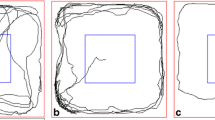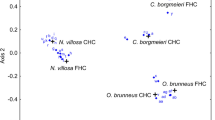Abstract
In this study, we focused on the relationship existing between the phenomenon of alternating turns and substrate-borne vibrations in woodlice, utilizing Armadillo officinalis as an experimental behavioral model. A T-maze with multiple exits was used to collect information on the pattern of turn alternation in (i) adult individuals of A. officinalis exposed and (ii) non-exposed to micro-vibrations, and (iii) juveniles of A. officinalis exposed to micro-vibrations. Turn alternation was assessed as the number of times that an animal turned on the opposite side in the T-maze. Our best model pointed out a statistically significant increased expected number of alternating turns for both groups of adult individuals, non-exposed and exposed to micro-vibrations, compared to exposed juveniles. Adults of A. officinalis seem to be very reactive to substrate-borne vibrations, unlike juveniles. This reactivity might be related to a defense mechanism developed as an evolutionary adaptation to the xeric environment, increasing progressively from the juvenile condition until the adult state. This feature might also fit into a complex network of inter- and intraspecific communication mediated by substrate-borne vibrations, like in insects.




Similar content being viewed by others
References
Agodi A, Oliveri Conti G, Barchitta M, Quattrocchi A, Lombardo BM, Montesanto G, Messina G, Fiore M, Ferrante M (2015) Validation of Armadillo officinalis Dumèril, 1816 (Crustacea, Isopoda, Oniscidea) as a bioindicator: in vivo study of air benzene exposure. Ecotox Environ Safe 114:171–178. https://doi.org/10.1016/j.ecoenv.2015.01.011
Barth FG (1982) Spiders and vibratory signals: sensory reception and behavioral significance. In: Witt PN, Rovner JS (eds) Spider communication. Princeton University Press, Princeton, pp 67–122
Brockett B, Hassall M (2005) The existence of an Allee effect in populations of Porcellio scaber (Isopoda: Oniscidea). Eur J Soil Biol 41(3-4):123–127. https://doi.org/10.1016/j.ejsobi.2005.09.004
Broly P, Mullier R, Deneubourg J-L, Devigne C (2012) Aggregation in woodlice: social interaction and density effects. ZooKeys 176:133–144
Broly P, Deneubourg JL, Devigne C (2013) Benefits of aggregation in woodlice: a factor in the terrestrialization process? Insect Soc 60(4):419–435. https://doi.org/10.1007/s00040-013-0313-7
Carbines GD, Dennis RM, Jackson RR (1992) Increased turn alternation by woodlice (Porcellio scaber) in response to a predatory spider, Dysdera crocata. Int J Comp Psychol 5:138–144
Carrettero MA (2004) From set menu to a la carte. Linking issues in trophic ecology of Mediterranean lacertids. Ital J Zool 71(sup2):121–133. https://doi.org/10.1080/11250000409356621
Caruso D, Costa G (1976) L’apparato stridulatore e l’emissione di suoni in Armadillo officinalis Duméril (Crustacea, Isopoda, Oniscoidea). Animal 3:17–27
Castilla AM, Vanhooydonck B, Catenazzi A (2008) Feeding behaviour of the Columbretes lizard Podarcis atrata, in relation to Isopoda (Crustaceae) species: Ligia italica and Armadillo officinalis. Belg J Zool 138:146–148
Cividini S, Montesanto G (2018) Changes in turn alternation pattern in response to substrate-borne vibrations in terrestrial isopods. Behav Process 146:27–33. https://doi.org/10.1016/j.beproc.2017.11.005
Cocroft RB, Rodriguez RL (2005) The behavioral ecology of insect vibrational communication. Bioscience 55(4):323–334.
Critchlow DE, Fligner MA (1991) On distribution-free multiple comparisons in the one-way analysis of variance. Commun Stat Theory Methods 20:127–139
Devetak D, Pabst MA, Lipovšek Delacord A (2004) Leg chordotonal organs and campaniform sensilla in Chrysoperla Steinmann 1964 (Neuroptera): structure and function. Denisia 13:163–171
Dwass M (1960) Some k-sample rank-order tests. In: Olkin I, Ghurye SG, Hoeffding W, Madow WG, Mann HB (eds) Contributions to probability and statistics. Stanford University Press, Stanford, pp 198–202
Faul F, Erdfelder E, Buchner A, Lang A-G (2009) Statistical power analyses using G*Power 3.1: tests for correlation and regression analyses. Behav Res Methods 41(4):1149–1160. https://doi.org/10.3758/BRM.41.4.1149
Harvey AW, Bovell NKA (2006) Spontaneous alternation behavior in Paramecium. Learn Behav 34(4):361–365. https://doi.org/10.3758/BF03193200
Hegarty KG, Kight SL (2014) Do predator cues influence turn alternation behavior in terrestrial isopods Porcellio laevis Latreille and Armadillidium vulgare Latreille? Behav Process 106:168–171. https://doi.org/10.1016/j.beproc.2014.06.005
Hill PSM (2001) Vibration and animal communication: a review. Am Zool 41:1135–1142
Hill PSM (2008) Vibrational communication in animals. Harvard University Press, Harvard
Hill PSM (2009) How do animals use substrate-borne vibrations as an information source? Naturwissenschaften 96(12):1355–1371. https://doi.org/10.1007/s00114-009-0588-8
Hill PSM, Wessel A (2016) Biotremology. Curr Biol 26:R181–R191
Hornung E (2011) Evolutionary adaptation of oniscidean isopods to terrestrial life: structure, physiology and behavior. Terr Arthropod Rev 4(2):95–130. https://doi.org/10.1163/187498311X576262
Houghtaling K, Kight SL (2006) Turn alternation in response to substrate vibration by terrestrial isopods, Porcellio laevis (Isopoda: Oniscidea) from rural and urban habitats in New Jersey, USA. Entomol News 117(2):149–154.
Hughes RN (1967) Turn alternation in woodlice (Porcellio scaber). Anim Behav 15(2-3):282–286. https://doi.org/10.1016/0003-3472(67)90013-9
Hughes RN (1978) Effects of blinding, antennectomy, food deprivation, and simulated natural conditions on alternation in woodlice (Porcellio scaber). J Biol Psychol 20:35–40
Hughes RN (1989) Phylogenetic comparisons. In: Dember WN, Richman CL (eds) Spontaneous alternation behavior. Springer, New York, pp 39–57. https://doi.org/10.1007/978-1-4613-8879-1_3
Hutchings M, Lewis B (1983) Insect sound and vibration receptors. In: Lewis B (ed) Bioacoustics: a comparative approach. Academic Press, London, pp 181–205
Kalmring K (1985) Vibrational communication in insects (reception and integration of vibratory information). In: Kalmring K, Elsner N (eds) Acoustic and vibrational communication in insects. Paul Parey, Berlin, pp 127–134
Lachman SJ, Havlena JM (1962) Reactive inhibition in the paramecium. J Comp Physiol Psychol 55(6):972–973. https://doi.org/10.1037/h0049191
Lehmann E (1975) Nonparametrics: statistical methods based on ranks. McGraw-Hill, New York
Lepley WM, Rice GE (1952) Behavior variability in paramecia as a function of guided act sequences. J Comp Physiol Psychol 45(3):283–286. https://doi.org/10.1037/h0056313
Messina G, Montesanto G, Pezzino E, Caruso D, Lombardo BM (2011) Diversity of terrestrial isopods in a protected area characterized by salty coastal ponds (Vendicari, Sicily). J Nat Hist 45(35-36):2145–2158. https://doi.org/10.1080/00222933.2011.587899
Messina G, Pezzino E, Montesanto G, Caruso D, Lombardo BM (2012) The diversity of terrestrial isopods in the natural reserve “Saline di Trapani e Paceco” (Crustacea, Isopoda, Oniscidea) in northwestern Sicily. Zookeys 176:215–230
Messina G, Montesanto G, Pezzino E, Sciandrello S, Caruso D, Lombardo BM (2014) Plant communities preferences of terrestrial crustaceans (Isopoda: Oniscidea) in a protected coastal area of southeastern Sicily (Italy). Biologia 69:354–362
Montesanto G (2015) A fast GNU method to draw accurate scientific illustrations for taxonomy. ZooKeys 515(515):191–206. https://doi.org/10.3897/zookeys.515.9459
Montesanto G (2016) Drawing setae: a GNU way for digital scientific illustrations. Nauplius 24:e2016017
Montesanto G, Cividini S (2017a) A crossover design to assess feeding preferences in terrestrial isopods: a case study in a Mediterranean species. Biologia 72:194–203
Montesanto G, Cividini S (2017b) The moult cycle of the terrestrial isopod Armadillo officinalis Duméril, 1816 (Crustacea: Isopoda: Oniscidea). Acta Zoologica (early preview). https://doi.org/10.1111/azo.12210
Ono T, Takagi Y (2006) Turn alternation of the pill bug Armadillidium vulgare and its adaptive significance. Jpn J Appl Entomol Zool 50(4):325–330. https://doi.org/10.1303/jjaez.2006.325
Popper AN, Salmon N, Horch KW (2001) Acoustic detection and communication by decapod crustaceans. J Comp Physiol A 187(2):83–89. https://doi.org/10.1007/s003590100184
Sandeman DC, Tautz J, Lindauer M (1996) Transmission of vibration across honeycombs and its detection by bee legs receptors. J Exp Biol 199(Pt 12):2585–2594
Schmalfuss H (1996) The terrestrial isopod genus Armadillo in western Asia (Oniscidea: Armadillidae) with descriptions of five new species. Stutt Beit Natur A 544:1–43
Schmalfuss H (2003) World catalog of terrestrial isopods (Isopoda: Oniscidea). Stutt Beit Natur A 654:1–341 Revised version available from: http://www.oniscidea-catalog.naturkundemuseum-bw.de/Cat_terr_isop.pdf
Sibly RM (1983) Optimal group size is unstable. Anim Behav 31(3):947–948. https://doi.org/10.1016/S0003-3472(83)80250-4
Steel RGD (1960) A rank sum test for comparing all pairs of treatments. Technometrics 2(2):197–207. https://doi.org/10.1080/00401706.1960.10489894
Taiti S, Paoli P, Ferrara F (1998) Morphology, biogeography, and ecology of the family Armadillidae (Crustacea, Oniscidea). Israel J Zool 44:291–301
Vandel A (1962) Faune de France: 66. Isopodes terrestres (deuxième partie). Le Chevalier, Paris
Verhoeff KW (1908) Über Isopoden: 15. Aufsatz. Archiv Biontol 2:335–387
Virant-Doberlet M, Čokl A (2004) Vibrational communication in insects. Neotrop Entomol 33(2):121–134. https://doi.org/10.1590/S1519-566X2004000200001
Warburg MR (2013) Post-parturial reproduction in terrestrial isopods: a partial review. Invertebr Reprod Dev 57(1):10–26. https://doi.org/10.1080/07924259.2011.633620
Warburg MR, Berkovitz K (1978) Hygroreaction of normal and dessicated Armadillo officinalis isopods. Entomol Exp Appl 2:55–64
Wickham H (2009) ggplot2: elegant graphics for data analysis. Springer-Verlag, New York. https://doi.org/10.1007/978-0-387-98141-3
Acknowledgements
Special thanks to Dr. Clara P. Amorim (Associate Editor) and the anonymous reviewers who checked over our manuscript for their valuable suggestions.
Author information
Authors and Affiliations
Corresponding author
Ethics declarations
All applicable international, national, and/or institutional guidelines for the care and use of animals were followed.
Conflict of interest
The authors declare that they have no conflict of interest.
Electronic supplementary material
ESM 1
(PDF 234 kb)
Appendix
Appendix
Settings of the parameters used in G*Power 3.1 for the sample size calculation and power analysis
Wilcoxon-Mann-Whitney nonparametric test (two groups)
Analysis: A priori (Compute required sample size)
Options: A.R.E. method
Input:
Tail(s) = Two
Parent distribution = Normal
Effect size d = 0.5
α err prob = 0.05
Power (1-β err prob) = 0.80
Allocation ratio N2/N1 = 1
T test: Difference between two independent means (two groups)
Analysis: Compromise (Compute implied α and power)
Input:
Tail(s) = Two
Effect size d = 0.5
β/α ratio = 4
Sample size group 1 = 67
Sample size group 2 = 67
Settings to generate the micro-vibrations used in the experiment with the software Audacity (ver. 1.2.4)
The option Noise was selected starting from the menu Generate.
In the window named Noise Generator, the following parameters were set:
-
Noise type: Brownian
-
Amplitude: 1
-
Duration: 3 min
The sound was normalized at − 4.0 dB with the command Normalize, in the Effect menu.
Rights and permissions
About this article
Cite this article
Cividini, S., Montesanto, G. Differences in the pattern of turn alternation between juveniles and adults of Armadillo officinalis Dumèril, 1816 (Isopoda, Oniscidea) in response to substrate-borne vibrations. acta ethol 21, 59–68 (2018). https://doi.org/10.1007/s10211-018-0282-y
Received:
Revised:
Accepted:
Published:
Issue Date:
DOI: https://doi.org/10.1007/s10211-018-0282-y




